The HTC Flyer Review
by Anand Lal Shimpi on June 21, 2011 4:05 AM EST- Posted in
- Tablets
- HTC
- Android 2.3
- Mobile
- Flyer
Performance
I began this review talking about how HTC is trying to break the mold with the Flyer. It's smaller than most tablets released in 2011, it has a stylus and it doesn't run Honeycomb. Arguably the biggest departure from the Releasing a Successful Android Tablet Handbook is in its SoC choice. While Acer, ASUS, LG, Motorola and Samsung have all shipped tablets based on NVIDIA's Tegra 2 SoC, the Flyer is powered by Qualcomm. Not only does it have a Qualcomm SoC, but unlike all of the Honeycomb tablets it is a single-core Qualcomm. The APQ8055 is what HTC picked for use in the Flyer.
At a high level here's what we know. Qualcomm's Scorpion core is still an in-order design with slightly higher IPC than the standard Cortex A8. ARM's Cortex A9 however moves out of order, but retains much of the overall architecture of the Cortex A8. The A9 is estimated to be up to 20% more efficient per clock as a result of its shorter pipeline and ability to reorder instructions around data dependencies. If we assume a single Scorpion core is no faster than a Cortex A8 at the same frequency, then a 1GHz Cortex A9 could be up to 20% faster than a 1GHz Snapdragon running single threaded integer code (I'll ignore the FP comparison at this point due to the whole pipelined vs. non-pipelined FPU issues of various SoCs). Running multithreaded code however, the advantage of two Cortex A9s over a single Scorpion core could be more than double. In reality there are very few heavily threaded apps in Android today. In our first Tegra 2 investigation we saw a 12 - 64% performance improvement for the dual-core Cortex A9 based Tegra 2 over 1GHz Cortex A8 and Scorpion based SoCs. I'd expect that 64% is likely the upper bound for the sort of performance advantage we'd see from Tegra 2 vs. a single core 1GHz in-order architecture (either Cortex A8 or Scorpion) in most well threaded tests.
Armed with this data let's look at what HTC decided to put in the Flyer. The APQ8055 has a single core Snapdragon capable of running at up to 1.5GHz. In the Flyer, HTC opted for a full frequency part - under load the Qualcomm APQ8055 runs at a full 1.5GHz. That's a 50% higher clock frequency than the 1GHz Scorpion core we used in the comparisons above. We know that for the most part tasks like web page rendering are almost completely CPU bound on these smartphones. Even browsing over the cellular network is very CPU limited at times. Based on what we know, it's very likely that a 1.5GHz single-core Scorpion would be as fast as or faster than a 1GHz dual-core Tegra 2 in a number of tasks.
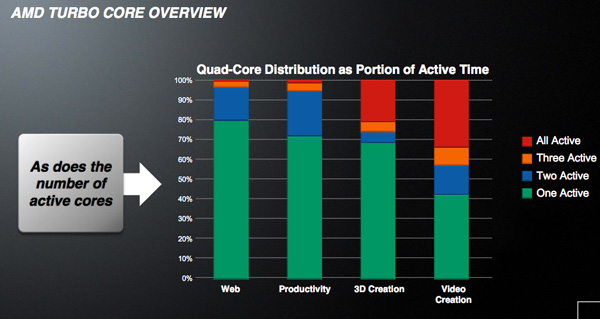
While two cores help with web based workloads, single threaded performance matters a lot
The slide above is something AMD shared with us for Llano but it conveys an important point. While multicore processors are necessary, single threaded or single core performance is still very important on the desktop. When you take into account that single threaded performance is significantly lower in smartphones than it is in notebooks/desktops, the importance of having fast individual cores in addition to multiple cores becomes more evident.
It's unlikely that a single-core 1.5GHz CPU is going to be faster across the board than NVIDIA's dual-core Tegra 2, however it's also unlikely that it'll be slower across the board. In fact, in actual application usage my money is on the single-core Snapdragon to provide a snappier experience (again with the puns). In practice I'd say that's pretty much the case. The Flyer doesn't feel as slow as most single core Android platforms I've used, when doing a single task it's easily up there with the Tegra 2 based tablets. Where the Flyer does struggle is when you have a rogue background task eating up CPU cycles. With two cores you have the ability to deal with hiccups in task scheduling, whereas with one you just have to wait until the scheduler switches threads. While I wouldn't recommend buying a single-core Android phone today, the Flyer is an exception.
Let's look at the performance data:
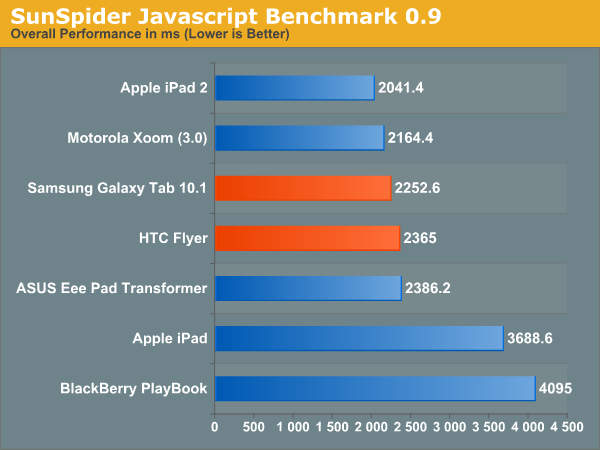
SunSpider 0.9.0 is neck and neck with the Tegra 2 based Eee Pad Transformer running Android 3.1. Granted some of that is due to the fact that Android 3.1 seemed to lower web browsing performance, but either way we're looking at a platform that is much faster than a standard 1GHz Snapdragon.
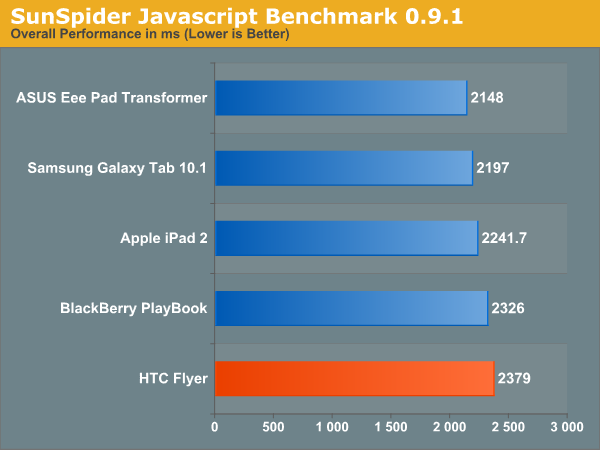
The Flyer is about 10% slower than the Eee Pad in version 0.9.1 of the test. Again, the 1.5GHz single-core SoC won't sweep these tests - but it'll at least be competitive with the dual-core Tegra 2 thanks to its excessive clock speed.
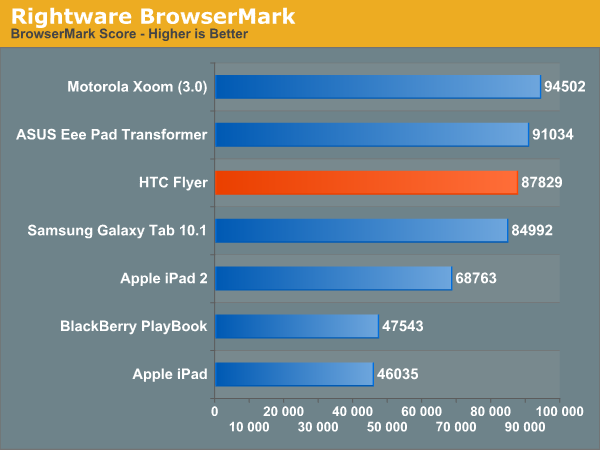
BrowserMark shows competitive performance to the Honeycomb based tablets - note that 3.1 slowed things down a bit for both ASUS and Samsung vs the original launch Xoom.
GPU performance is another story entirely. OpenGL ES 2.0 performance seems competitive but mostly due to the Flyer running at a lower screen resolution:
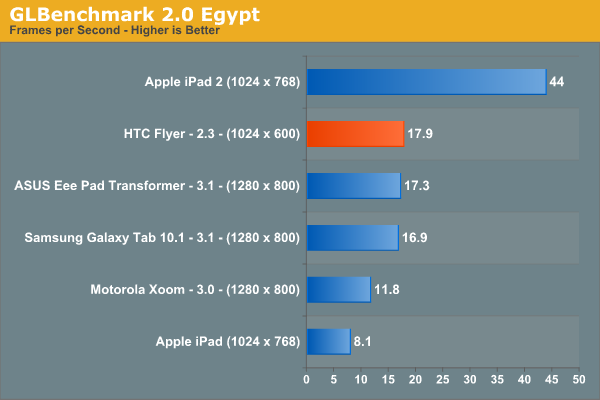
The PRO test however gives NVIDIA a considerable lead, despite its higher rendering resolution.
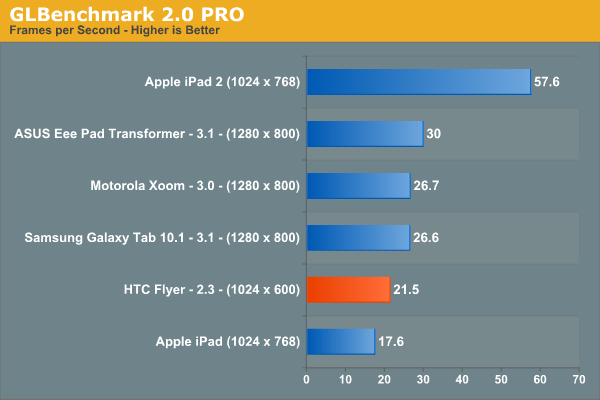
BaseMark ES2 however clearly favors the Adreno 205 GPU inside the Snapdragon SoC, it manages nearly double the performance of the Eee Pad here:

I suspect the advantage in BaseMark is more due to driver/benchmark optimization than what you should expect to see in terms of 3D performance vs. Honeycomb tablets.
Flash and HTML5 performance range from competitive to downright faster than Android 3.1 based tablets as you can see from our results below:
| Flash/HTML5 Performance - GUIMark 3 | ||||||||
| Bitmap (HTML5 Cache) | Bitmap (Flash) | Vector Test (HTML5) | Vector Test (Flash) | Compute (HTML5) | Compute (Flash) | |||
| HTC Flyer | 30.3 fps | 50.6 fps | 12.1 fps | 21.4 fps | 8.5 fps | 26.6 fps | ||
| Samsung Galaxy Tab 10.1 | 22.9 fps | 25.0 fps | 11.4 fps | 19.3 fps | 11.2 fps | 23.6 fps | ||
WiFi Connectivity and Performance
The Flyer lacks 3G support (although the EVO View 4G on Sprint is an EVDO + WiMAX version of the Flyer) and instead ships with 802.11b/g/n support. Wireless reception was very good in my usage, easily maintaining a connection to an AP very far away and rarely accessible on most mobile devices. Performance however is not competitive with the other Honeycomb based tablets we've reviewed this year:
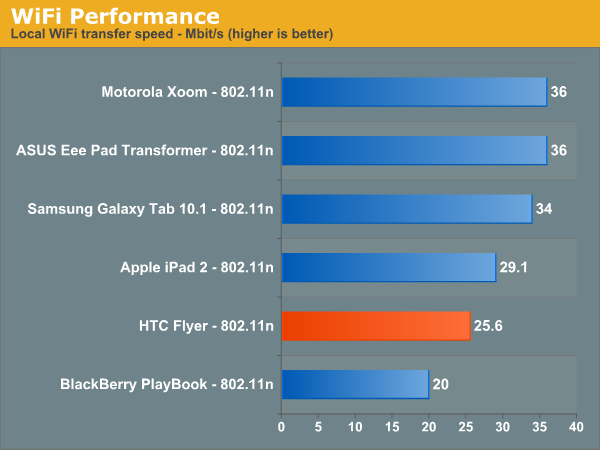
Note that this is peak performance. Average speed was much lower on the Flyer at just under 20Mbps and I saw lows drop below 16Mbps whereas consistently getting above 30Mbps on the Honeycomb tablets isn't an issue.










26 Comments
View All Comments
aranyagag - Tuesday, June 21, 2011 - link
99.999% of the time. I am the only person in the surgery wards, OPD, and OTs carrying a tablet. Because my Samsung galaxy tab (the original 7 inch version) can fit into trouser pockets (even though just barely). There are four other people in my department who have iPads (both versions 1 and version 2), but they are always, and I repeat ALWAYS left at home. The only time when another tablet comes into our domain is when somebody from another department comes in with a galaxy tab (7 inch). This is because THEY say that instead of carrying along and iPad it is easier to carry along their laptops.It seems, however, that Samsung must have done a lot of research before deciding the dimensions of of my tablet, because even with a cover it refuses to fit into any pocket. This means that while it may fulfill one aspect of my use-- Using the tablet while on rounds, the HTC flyer cannot be carried as easily and hence is not as useful.
To summarise, I would like to quote something that my head of the department said oon seeing me use my tablet, "I have an iPad 2 , but it remains on my bedside table acting as a radio".
Impulses - Tuesday, June 21, 2011 - link
Altho I agree that it's too expensive (specially for a service that may forever lag behind the pack in OS updates), I do hope it does well enough for HTC to release a Flyer 2 next year. The digitizer is intriguing, particularly if it gains more app support.Personally I don't have a problem spending $500 on a tablet, but I know companies like ASUS will have brought prices down across the board within a few months... And there's still plenty of innovation to come from devices like this and the ASUS Transformer (part of what makes Android great imo).
If the smartphone market is still in it's infancy, the tablet market is barely out of the womb...
chomlee - Wednesday, June 22, 2011 - link
499 for a 7" pad???? I was hoping HTC was going to be the company to break the IPad streak like they did with the EVO and Iphone. What a joke. These marketing people at all the tablet companies should all be fired, except for Asus. Asus is the only company to offer a decent alternative at a lower price. What kind of idiot are you if you are trying to compete in a market and say " are device is going to be smaller than the competition, not as good, and with much less battery life, but we are going to charge the same".They need to take a lesson from Asus and realize that you can't offer a device that is "almost" as good as the current leader and charge the same. You either have to be noticably better, and/or cheaper.
Maybe the only reason why they did so well with the EVO was because loyal sprint customers couldn't get an Iphone.
ap90033 - Wednesday, June 22, 2011 - link
TOTALLY AGREE WITH YOU!!! Flyer=Fail...ap90033 - Wednesday, June 22, 2011 - link
Looks lame to me. To be so small it seems to have crappy battery life. Seems like the wanna be Tablet with a "special" UI that isnt really that awe inspiring. Its to big to be a phone, its to small to be a tablet. Its like a Phablet! I also dont get the reference to all the suck behind honeycomb. I have the Eee Pad with 3.1 and its GREAT. No issues, 9+ hours battery life and zippy performance. All for the low low price of $399 (that cheaper than the poser Flyer btw)... Maybe I am wrong here, but I feel a tablet and a phone are currently two different things. I bought a tablet as a fairly functional camera/browser/video/email/word processor type device and I have a Phone (HTC Evo running 2.3.3) for my phone and more on the go needs...grenzo - Tuesday, July 5, 2011 - link
I bought the 3g+WiFi 32gb Flyer with pen here in Singapore for usd730. For weeks I was waiting for the arrival of the 10in tegra 2 honeycomb tablets but I found that I wanted my tablet to be more portable, something I can carry without a bag and hold with one hand while standing in the train. 1.5ghz with 1gb ram is plenty powerful for this device. Games like Gun Bros and Pocket legends perform very well. It would have been great if this was running honeycomb but very happy with what HTC has done with HTC sense. I can wait until HTC is ready to upgrade this to hc. In the 7 in space the Flyer is way ahead of the rest. Yes it seems a lot of money to pay for the specs, but in terms of real world use this is a fast smooth tablet with a great screen. Web browsing, email, news, weather, games, all work almost perfectly. Camera is bad but i can live with that. Pen is just a nice plus. Evernote integration is great but I use the screen keyboard more often than the pen.I saw a video comparing the browsing speed of this and the iPad 2 and at times this came out faster. They also showed that Angry Birds loads slightly faster on this device than the iPad 2 but they still dissed the Flyer because of its processor and OS. Its not just what's on paper but you have to see how it actually performs.
The other Android tablets like the ASUS transformer offer more value for money but i don't want to spend hundreds of dollars on a portable device that i will leave at home most of the time.